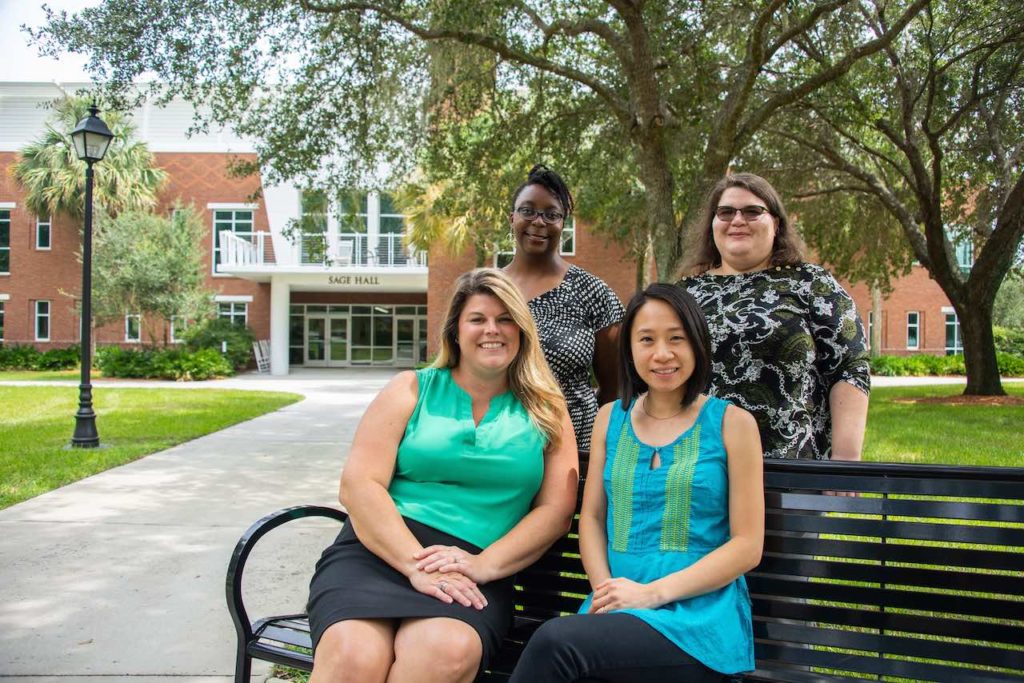![]()
Faculty, students to use the inverted fluorescent
microscope in biology, health sciences, physics research
Stetson University has received a $266,000 Major Resource Instrumentation Grant from the National Science Foundation (NSF) to purchase an inverted fluorescent microscope system capable of imaging over a wide range of living biological samples from subcellular structures to small organisms.
The microscope system will be used at Stetson to engage undergraduate students across biology, health sciences and physics in superior training through faculty-mentored research projects, and promote the implementation of inquiry-based lab experiences for students in upper-level biology and physics courses.
“This really opens up new avenues of research at the cell and, especially, the sub-cell level at Stetson,” said Holley Lynch, PhD, assistant professor of physics and Stetson’s principal investigator. “We have a growing number of researchers who work with that scale in three departments. And it will allow students to use a research-grade microscope.”

Cancer Cell: A microscopic image of HeLa cancer cells stained with chemical dyes
to visualize with internal structures (red and green) and DNA (blue) labeled.
(Photo Credit: Stetson University/Lynn Kee)
Lynch noted that while some of Stetson’s science faculty/researchers need to see “very small things, such as look inside cells,” others need to see how cells behave over time. The new system, which is expected to arrive on campus later this fall, is “flexible,” she said.
“I see this as a really good stepping-stone. Having this equipment here enables us to apply for other kinds of grants that will fund our research and take our students to the next level,” said Heather Evans-Anderson, PhD, assistant professor health science and a co-principal Investigator along with Lynn Kee, PhD, assistant professor of biology; and Roslyn Crowder, PhD, associate professor of biology.
Highlights of the anticipated research: 1) tracking migrating cells in living tissues to link cellular and subcellular mechanisms to tissue-scale movements; 2) examining improperly located cell death proteins in malignant cells; 3) dissecting communication pathways that regulate cardiac myocyte cell proliferation and regeneration in Ciona intestinalis; 4) examining spatial organization and dynamics of iridescent marine bacteria; and 5) promoting education through use of CRISPR/Cas9 gene editing technology by undergraduates in a Genetics course to manipulate and label genes in order to visualize effects in living organisms.

National Science Foundation Grant Recipients at Stetson University: Principal investigators: Top left, Roslyn Crowder, PhD, associate professor of biology; top right, Holley Lynch, PhD, assistant professor of physics; bottom left, Heather Anderson-Evans, PhD, assistant professor of health sciences; bottom right: Lynn Kee, PhD, assistant professor of biology (Photo Credit: Stetson University/Ciara Ocasio)
Also, the system will provide a substantial foundation to support and enable fundamental pioneering research by junior faculty members, and foster sophisticated capstone research for seniors under the mentorship of faculty members committed to student training and advancing the participation of underrepresented and minority undergraduates in the sciences.
Collectively, these invaluable experiences will promote scientific competency in students as they achieve a comprehensive range of career goals and contribute to the development of the next generation of scientists.
In 2018, Kresge Foundation funds led to Stetson’s acquisition of an advanced stereo microscope, which effectively aids in the visualization of tissue layers and development of organisms. The new microscope system will deliver even greater power of magnification and capability to see inside cells, Evans-Anderson said, adding that extensive interdepartmental collaboration will result.
The NSF, created by the United States Congress in 1950 to “promote the progress of science,” among other initiatives, deemed the Stetson grant’s intellectual merit and broader impacts a reflection of its statutory mission and worthy of funding. The Major Research Instrumentation Grant program accepted 805 funding proposals, requesting more than $557 million, and only 130 to 145 awards were given.
With an annual budget of $8.1 billion, NSF is the funding source for approximately 27% of the total federal budget for basic research conducted at U.S. colleges and universities.
About Stetson University
Founded in 1883, Stetson University is the oldest private university in Central Florida. Stetson focuses on intense learning experiences in a supportive community that allows students to develop their voice in a connected, inclusive environment. Stetson University ranks No. 5 on U.S. News & World Report’s 2019 list of Best Regional Universities (South), and has been recognized as one of The Princeton Review’s 385 Best Colleges, 2020 edition. Stay connected with Stetson on social media.
